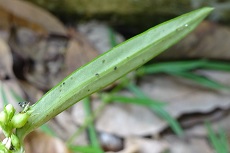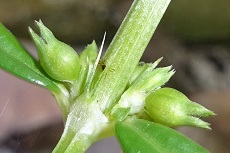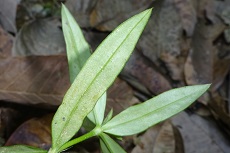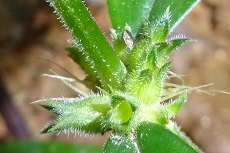| Home | Nature Weekly Index |
17 April 2016 | Buttonweeds | Family: Rubiaceae |
Buttonweed is a common name referring to a group of weedy herbaceous plants with flower clusters that looks like buttons. In Singapore, members in this group that belong to the Rubiaceae family. They are represented by 3 genera, namely Spermacoce, Oldenlandia and Mitracarpus. Not all members in these genera have flower clusters that look like buttons. There is another genus known as Hedyotis, but most in this genus are now being migrated to the genus Oldenlandia based on the information from the Plant List website.
I did a short write up on all the available buttonweed in Singapore back in 2012. Since then, I had not seen another new buttonweed until December last year. That was when I found Oldenlandia verticillata in a park. Before that, I had name another buttonweed (Spermacoce verticillata) with narrow leaves as Oldenlandia verticillata. When I checked the Flora of China website recently, it described Oldenlandia verticillata as “often decumbent” (meaning: lying along the ground or along a surface). It took me a while to feel confident on the identity of this plant because it looks very similar to another buttonweed, Spermacoce ocymifolia. The distinction between the two is that Spermacoce ocymifolia takes on an erected posture instead of having its belly along the ground.
Last week, another surprise related to buttonweed came along. I found another new buttonweed in the same area that I first saw Oldenlandia verticillata. This particular buttonweed has very narrow leaves and most of its stem goes along the ground as well. After some checks, I had identified it as Oldenlandia tenelliflora, thus adding another new plant for my website. Oldenlandia tenelliflora looks similar to Oldenlandia diffusa except that Oldenlandia diffusa is a much smaller plant and its flower has a stalk.
Both of the newly found herbaceous plants were not listed in the Singapore Flora checklist published in 2009. Below are pictures of the 3 plant for comparison. I had included pictures of Spermacoce ocymifolia as reference.




.jpg)

.jpg)

.jpg)
.jpg)
.jpg)
.jpg)
Update: 15 January 2025
While writing a new post on buttonweeds, specifically on Richardia scabra (Rough Mexican Clover) and Spermacoce species in January 2025, I have updated the Buttonweeds article that was initially posted in 2012 in my Nature Observation Series section. Additionally, the botanical names of the buttonweeds also need to be updated.
I previously applied the name Oldenlandia auricularia (also referred to as Hedyotis auricularia and Exallage auricularia) to the wrong plant in the above note. The correct identification should be Spermacoce ocymifolia, and this has now been updated. Additionally, the names Oldenlandia tenelliflora and Oldenlandia verticillata have been revised to Scleromitrion tenelliflorum and Scleromitrion verticillatum, respectively. However, in the text of the aforementioned note, I have retained the previous names while updating the links to their corresponding image decks.
As a note, the 2022 Singapore flora checklist has listed Scleromitrion verticillatum as Hedyotis verticillata. I have chosen to follow the convention used by the Plants of the World Online website, which treats Hedyotis verticillata as synonym. Regarding Scleromitrion tenelliflorum and its synonyms (Hedyotis tenelliflora and Oldenlandia tenelliflora), they are not included in the flora checklist. The species that appears similar to Scleromitrion tenelliflorum in the flora checklist is Hedyotis pinifolia (a synonym of Scleromitrion pinifolium); however, I am doubtful that the plant I observed was Scleromitrion pinifolium.
Due to the obsolescence of the Plant List website, the link to the website has been removed.